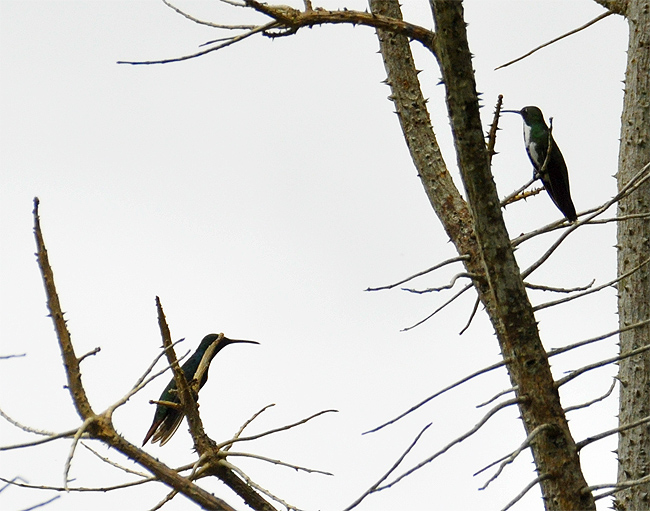
green-throeated mango
[order] Apodiformes | [family] Trochilidae | [latin] Anthracothorax nigricollis | [UK] Black-throated Mango | [FR] Mango a cravate noire | [DE] Schwarzbrust-Mangokolibri | [ES] Mango Gorginegro | [IT] Mango collonero | [NL] Zwartkeelmango
Subspecies
Monotypic species
Physical charateristics
The male has glossy bright green upperparts. His throat and chest are matt black, bordered with blue-green. The flanks are bright green, and the black of the chest tapers onto the belly.
The female Black-throated Mango has bronze-green upperparts and white underparts with a black central stripe. Immature birds show some grey or buff feather tips on the head and wings, and have brown around the eyes.
The female Black-throated Mango has bronze-green upperparts and white underparts with a black central stripe. Immature birds show some grey or buff feather tips on the head and wings, and have brown around the eyes.
Listen to the sound of Black-throated Mango
[audio:http://www.aviflevoland.nl/sounddb/B/Black-throated Mango.mp3]
Copyright remark: Most sounds derived from xeno-canto
| wingspan min.: | 0 | cm | wingspan max.: | 0 | cm |
| size min.: | 10 | cm | size max.: | 11 | cm |
| incubation min.: | 16 | days | incubation max.: | 18 | days |
| fledging min.: | 24 | days | fledging max.: | 25 | days |
| broods: | 2 | eggs min.: | 1 | ||
| eggs max.: | 3 |
Range
The Black-throated Mango breeds from Panama south to northeasterm Bolivia, southern Brazil and northern Argentina. It is also common on both Trinidad and Tobago.
Habitat
Open garden-like vegetation with scattered bushes and trees. Cultivated slopes of mountain range; always in tropical areas.
Reproduction
The female Black-throated Mango lays two white eggs in a tiny cup nest 8-15 meter highon a usually bare branch. Incubation by the female is 16 or 18 days, and fledging another 24 days. Young stay with female after fledging for another 3-4 weeks. 2 broods.
Feeding habits
The food of this species is nectar, often taken from the flowers of large trees. This hummingbird is also notably insectivorous, often hovering in open areas to catch flying insects.
Conservation
This species has a large range, with an estimated global extent of occurrence of 9,900,000 km2. The global population size has not been quantified, but it is believed to be large as the species is described as ‘frequent’ in at least parts of its range (Stotz et al. 1996). Global population trends have not been quantified, but the species is not believed to approach the thresholds for the population decline criterion of the IUCN Red List (i.e., declining more than 30% in ten years or three generations). For these reasons, the species is evaluated as Least Concern.

Migration
Migrates to higher elevations in august-september. Long distance migration reported in East Brazil
Distribution map

]]>
